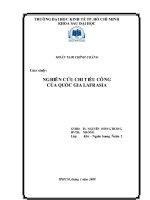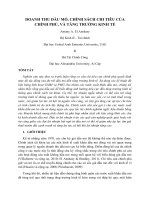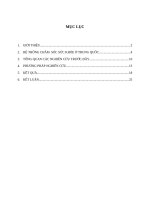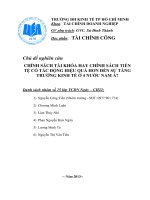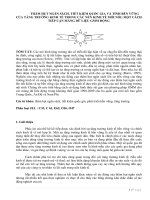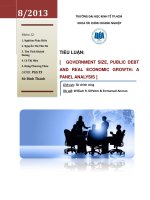Tiểu luận tài chính công ARGENTINAS2001DEBTCRISISANDPROPOSALSFORVIETNAM
Bạn đang xem bản rút gọn của tài liệu. Xem và tải ngay bản đầy đủ của tài liệu tại đây (1.12 MB, 17 trang )
ARGENTINA’S 2001 DEBT CRISIS AND PROPOSALS FOR VIETNAM
Table of Contents
I. CAUSES AND CHRONOLOGY OF ARGENTINA ECONOMIC CRISIS IN 1998-2002
3
1. CAUSES OF ARGENTINA ECONOMIC CRISIS IN 1998-2002
2. CHRONOLOGY OF THE DEBT CRISIS IN ARGENTINA
3
5
II. ARGENTINE ECONOMY IN 2002-2016
6
1. OVERVIEW OF ARGENTINA ECONOMY AFTER THE 2001 DEFAULT
1.1. PERIOD 2002-2007
1.2. PERIOD 2008-2009
1.3. PERIOD 2010-2016 (THE ARGENTINIAN 2014 DEFAULT)
2. ARGENTINA ECONOMIC OUTLOOK IN 2016 AND ECONOMIC FORECAST
6
6
9
10
10
III. PROPOSALS FOR VIETNAM
12
1. VIETNAM’S CURRENT DEBT SITUATION
2. VIETNAM’S CURRENT PUBLIC DEBT STATUS VERSUS ARGENTINA’S IN 2001
3. PROPOSALS FOR VIETNAM
12
13
14
Introduction
In the first decades of 20th century, Argentina was one of the wealthiest country in the world.
However, since the end of World War II, Argentina experienced several economic and political
crises which caused Argentina to lose its high position on the world stage. In the early 1990s,
Argentina struggled with soaring inflation up to thousands percent, however, the new
administration addressed it and drove Argentina economy to the new period of development.
Nevertheless, after a decade, Argentina announced the default of its external debt in December
2001. Moreover, Vietnam’s current public debt issue is drawing close attention from its
citizens, therefore, studying the case of Argentina might provide a better knowledge on the
issue of Vietnam. With that in mind, in this thesis, we will dictate the causes of Argetina’s
debts crisis, have a brief outlook on its economic over 15 years after the default as well as a
simple comparison between Vietnam’s current debts status and Argentina’s debts crisis in the
early 2000s, and then propose some measures for Vietnam to keep its debt ratio in safe zone.
I.
Causes and chronology of Argentina economic crisis in 1998-2002
1. Causes of Argentina economic crisis in 1998-2002
Under the President Alfonsin’s administration, Argentine austral was issued as a new currency
to pay foreign debts. However, the 1989 hyperinflation led to Austral devaluation. When Carlo
Menem took office as Argentina’s President in 1989, he brought some political stability and
significant economic growth as he carried out a number of strong measures to restructure the
economy, including promoting trade liberalization, building competitive market economy
without the state’s interference, privatizing state-owned enterprises and sell them to foreign
owners…
On one hand, the reforms levered foreign investment inflow to Argentina, which was an
important source of foreign currency for the Government to pay off previous debts. In 1991,
Argentina’s Government adopted the Convertibility Plan. Among the most important contents
were the following:
The establishment of the currency board;
The issuance of the new currency called Peso to replace Austral, in which 1 Peso =
10,000 Austral;
Setting the exchange rate between Peso (ARA) and USD: 1 ARA = 1 USD; i.e. pegging
with the Dollar
Strictly control of the money issued to ensure amount of the peso in circulation is in
line with the amount of dollars in circulation.; which in practice officially promoting
dollarisation
The Convertibility Plan can temporarily control the inflation, from more than 3,000% in 1991
to 10% in 1993 and 4.7% in 1994, making Argentina one of the most favorite emerging market
on Wall Street (Figure 2). As a result, the country was able to borrow relatively cheap in USD
this period, causing the country increasingly dependent on foreign capital. Furthermore, the
banking system also witnessed high level of dollarization as it lent in dollars at the traditional
interest rate.
Figure 1. Dollarization of the Financial System (in %), 1991-2001
Source: Central Bank of Argentina
Figure 2. Inflation and Unemployment in Argentina, 1980-2002
Source: IMF
As the result of the reform, the Argentine economy entered a period of economic growth
between 1991 and 1997 (Figure 3). Only in 1995 output growth was negative, due to the socalled Tequila crisis in Mexico. The quick return of high economic growth in 1996, however,
suggested that the Argentine economy was strong enough to counter external shocks. This
further strengthened the confidence in the implemented policies, including the Convertibility
Plan.
Figure 3. GDP Growth in Argentina, 1980-2006
Source: World Bank
Nevertheless, in 1998, Brazil’ real encountered a strong depreciation, making Argentine export
declined significantly as Brazil is Argentina’s major trading partner. Trade deficit was
inevitable when export and import grew at about 8%/ year and 25%/year respectively in the
period 1990-1998. In addition, the USD appreciated and reached its highest level in 15 years
while Argentine central bank could not apply monetary or exchange rate policy to response to
the growing economic issues, making it fall into crisis in 1998. Consequently, foreign investors
lost their confidence in the Argentina economy, causing the sharp increase in borrowing costs.
This way, the country had remarkably lost its access to the international financial markets in
2001.
2. Chronology of the debt crisis in Argentina
Time
Event
March, 2000
IMF agreed a 7.2 billion USD loan for Argentina in three years
on condition that the country tightened its finance and achieved
GDP growth of 3, 5% in 2000
May, 2000
Argentine government announced a 1 billion USD budget cut
with the that "financial responsibility" could restore confidence
in the economy.
December, 2000
President De La Rua’s administration, successor of Carlo
Menem, announced the need for a 40 billion USD package of
assistance from the IMF.
January, 2001
As the Argentine economy continued to decline, IMF increased
its March 10, 2000 lending to 7 billion USD as part of a 40 billion
USD package. This loan was supposed to ensure the country's
GDP will grow at a rate of 2.5 percent in 2001.
June, 2001
Peso was depreciated by 7% to USD with the expectation of
improving its international trade competitiveness.
July, 2001
Argentine Congress adopted a "Zero Deficit Law", requiring a
balanced budget in the fourth quarter of 2001.
September, 2001
Basing on Argentina's commitment to enforce the “Zero Deficit
Law”, IMF increased its loan commitments to $ 7.2 billion.
November, 2001
The Government changed 60 billion USD of bonds at the average
interest rate of 11-12% per year for longer term bonds at the
interest rate of only 7%. Consequently, people rushed to
withdraw money from commercial banks, making the reserves of
the central bank reduced about 2 billion USD per day. President
De La Rua imposed a personal withdrawal limit of 1,000 USD
per month.
December, 2001
IMF refused to lend 1.24 billion USD on the grounds that
Argentina was unable to meet its financial targets. Later on,
Argentina announced its inability to repay its foreign debt.
January, 2002
Congress-chosen President Eduardo Duhalde decided to
implement the Law of Public Emergency and Reform of the
Exchange Rate Regime, marking the end of the Convertibility
Plan. At first, the peso is devalued from 1 peso per Dollar to 1.4
peso per Dollar. Later on, the exchange rate will become fully
floating, which allows the peso to depreciate even further.1
II. Argentine economy in 2002-2016
1. Overview of Argentina economy after the 2001 default
1.1. Period 2002-2007
The economic recovery began in the second quarter of 2002, following a damaging
recession, and continued until the world economic slowdown and recession of 2008-2009.
As can be seen from the chart, Argentina’s real GDP reached its pre-recession level after
three years of growth, in the first quarter of 2005.
Figure 4. Argentina’s quarterly real GDP level, 1993-2007
Source: DNCN, INDEC
1
Wiel, I. (2013). The Argentine crisis 2001/2002. Retrieved from
/>
Figure 5. Argentina’s selected employment and social indicators
Source: INDEC
The impact of this rapid and sustained growth can be seen in the labor market and in
household poverty rates. The chart shows the evolution of unemployment and poverty
rates during the recovery. Unemployment fell from 21.5 percent in the first half of 2002
to 9.6 percent for the first half of 2007. The employment-to-population ratio rose from
32.8 percent to 43.4 percent during the same period. And the household poverty rate
fell from 41.4 percent in the first half of 2002 to 16.3 percent in the first half of 2007.
These are very large changes in unemployment, employment, and poverty rates.
Figure 6. Argentina’s main economic indicators, 2002-2007
Source: MECON, BCRA, INDEC
A number of government policies seem to have contributed to Argentina's rapid and
robust recovery. Perhaps the most important of these policies was the government's
exchange rate policy. At the beginning of 2002, the exchange rate became fully floating,
which allow the pesos to depreciate rapidly from 1 pesos/USD to 3.6 pesos/USD in
May 2002. The devaluation had caused a significant increase in inflation, which then
running at more than 25 percent annual rate. Thus, it was important for the government
to stabilize the nominal exchange rate, not only to help stabilize inflation but also the
financial system. This was done primarily through interventions in the foreign exchange
markets (selling dollars), and also by restricting the outflow of pesos from the banking
system. By the second half of 2002, the government was intervening in the opposite
direction, buying dollars to slow the appreciation of the peso.
In 2003 the government began to conduct what would become the central bank's
exchange rate policy for the rest of the recovery, that of maintaining "a stable and
competitive real exchange rate." The policy contributes to the predictability of
important prices for producers to consider in their investment decision, as well as allows
domestic producers of tradable goods and services to compete in world markets.
Figure 7. Argentina’s reserves and exchange rate
Source: World Bank
Another important policy concerns the default and renegotiation of the government's
external debt. In 2005 after a delay of more than three years, a supermajority of creditors
(about 76 percent2) accepted a debt swap that took $67.3 billion of foreign debt off the
books. This was a record 65.6 percent "haircut" and was very important to Argentina's
recovery3. On the contrary, the default appears to have been necessary for the country
to change its macroeconomic policies so as to restore economic growth. Before the
default, the government was focused on tightening its fiscal and monetary policies in
an attempt to restore credibility among its creditors, an effort that included maintaining
the convertibility system. The debt swap enabled the government to pursue a new set
of successful macroeconomic policies, for example labour market and social measures4.
2
Dhillon, A., Garcia-Fronti, J., Ghosal, S., & Miller, M. (2006). Debt restructuring and
economic recovery: analysing the Argentine swap. Retrieved from
/>df
3
Weisbrot, M., & Sandoval, L. (2007). Argentina’s economic recovery: policy choices and
implications. Retrieved from
/>4 International Institute for Labour Studies. (2011). Argentina - Case study of past crises. ECIILS Joint Discussion Paper Series No. 3
1.2.
Period 2008-2009
The global financial crisis hit Argentina in late 2008 after the country’s economy had
been enjoying a prolonged recovery from its 2001-2002 economic crisis, however the
impacts were relatively modest and short-lived. The crisis started to have an impact on
the Argentine economy at the end of 2008 (Q4) and beginning of 2009 (Q1), as
quarterly GDP fell by 1.1 and 0.4 per cent respectively. The goods production sector
was the hardest hit, in particular subsectors related to construction and foreign trade.
Exports declined by 19 per cent reduction during the first semester of 2009 mainly
through declines in sales from the automotive sector. Growth at the end of 2009 proved
stronger (1.3 percent), thanks to the revival of growth in some of Argentina’s export
markets, notably to Brazil and China. In particular, the rebound was strong in
manufacturing and agriculture according to International Labour Office 5.
Figure 8. Argentina Quarterly GDP
Source: OECD Data
5
International Institute for Labour Studies. (2011). Argentina - Case study of past crises. ECIILS Joint Discussion Paper Series No. 3
1.3.
Period 2010-2016 (the Argentinian 2014 default)
During the period 2010-2016, Argentine economy saw a downturn in GDP growth rate.
Notably, for the second time in 13 years, Argentina was “imminent in default” 6 in 2014
after not being able to reach an agreement with holdout investors7 which would have
allowed debt-restructured bondholders to be paid. In 2005 and 2010, Argentina tried to
make a negotiation with the holders of its 2001 defaulted debt in which they offer new
“exchange bonds” that paid about 35 cents on the dollar of the original ones. Eventually,
93 percent of the old bondholders accepted the new ones. The other 7 percent was mostly
US hedge funds (holdout investors) that bought debt cheaply after Argentina's economic
crisis and wanted to have full repayment. They took the case to the US court and won, but
Argentina appeals the verdict. The US courts have blocked interest payments, which
already deposited by the Argentinean government in New York, to debt-restructured
bondholders until agreement with the holdout investors is reached. Thus, Argentina did not
pay on due date to debt-restructured bondholders and theoretically defaulted.
Figure 9. Argentina’s GDP Growth (annual %)
Source: World Bank
2. Argentina economic outlook in 2016 and economic forecast
Argentina recorded a government debt equivalent to 54.20 percent of the country's GDP in
2016, a 0.7 percentage point rise from 2015 when it was 53.5 percent of GDP. This amount is
the 64th highest government debt to GDP according to Ieconomics.com and its projection for
2017 is 61.1 percentage.8
6
BBC. (2014). Argentina defaults for second time. Retrieved from
/>7
The investors, also known as "hold-outs", are US hedge funds that bought debt cheaply after
Argentina's economic crisis. They never agreed to the debt swap accepted by the majority of
bondholders.
8
Ieconomics. (2017). Argentina - Government debt to GDP. Retrieved from
/>
Figure 10. Argentina government debt to GDP
Source: TrandingEconomics.com
Figure 11. Argentina economy data
Indicators
2012
2013
2014
2015
2016
GDP per captital (USD)
13,885
14,540
13,133
14,854
12,507
GDP (USD bn)
579
614
560
641
545
Economic Growth (GDP, %)
-1.0
2.4
-2.5
2.6
-2.2
Consumption (%)
1.1
3.6
-4.4
3.5
-1.4
Investment (%)
-7.1
2.3
-6.8
3.8
-5.1
Unemployment Rate
7.2
7.1
7.3
7.1
8.4
Exchange Rate (vs USD)
4.92
6.52
8.46
12.94
15.86
Inflation Rate (CPI, %)
10.0
18.4
38.0
26.7
41.2
Source: FocusEconomics
Argentina’s economic activity started to pick up in the second half in 2016, driven by strong
exports in the agriculture sector, helped by recent reforms such as the elimination of export
taxes. Private consumption was held back. 2016 witnessed a rapid fall in investment from 3.8
to -5.1 percent of GDP. Though Argentina unemployment rate fluctuated substantially in recent
years, it tended to decrease through 1996 - 2016 period ending at 8.4 percent in 2016. Despite
the fact that Argentina’s government expected the annual inflation rate to be between 35.0
percent and 36.0 percent in 2016, inflation increased significantly by 41.2% in 2016.
Figure 12. Argentina: Demand, output and prices
Source: OECD Economic Outlook 101 databases
Argentina’s economic growth is projected to rebound strongly in 2017 and 2018 as recent
reforms gain traction and exports strengthen. Investment will be a key driver of growth,
supported by stronger infrastructure investment, an improving business climate and rising
capital inflows. Exports will benefit from recent reforms, such as the removal of export taxes,
and the improving outlook in trading partners, especially Brazil. Private consumption will pick
up, driven by increases in real wages, as the labor market improves and inflation falls.
III. Proposals for Vietnam
1. Vietnam’s current debt situation
By the end of 2016, Vietnam’s public debt stood at 64.73 per cent of GDP, up from 62.2 percent
in 2015 and 50.1 per cent in 2011, while government debt and foreign debt stood at 53.6 percent
and 44.3 percent of GDP, respectively (Figure 13)9. State expenditures reached 28 percent in
2016 and was forecasted to be the same in 2017.
Figure 13. Vietnam’s external debt by years
External Debt
2012
2013
2014
2015
2016
39.5
38.5
39.3
41.7
44.3
(% of GDP)
Source: Focus-economics
Than, X. (2017). Dư nợ công Việt Nam khoảng 64.73%GDP tính đến cuối năm 2016
[Vietnam’s public debt is about 64.73% by the end of 2016]. Retrieved from
/>9
Until the end of 2016, Vietnam has just issued international bonds for 3 times to mobilize
capital from the international financial market with the total value of $2.75 billion (Figure 14).
Figure 14. Vietnamese government international bonds
Issue size
($USD million)
Maturity
(years)
date Coupon
2005
750
10
6.875%
2010
1000
10
6.750%
2014
1000
10
4.800%
Source: MoF’s Statistics
2. Vietnam’s current public debt status versus Argentina’s in 2001
In the comparison with Argentina in 2001, Vietnam’s debt scenario is still more brightening.
According to Moody’s Investors Service- a bond credit rating business- rank Vietnam B1
positive, a safety position. Vietnamese economy has still been in a high-growth period with the
average economic growth rate around 6-7 percent annually, in 2016 and 2017, its economic
growth rate are 6.2 percent and 6.7 percent-forecasting, respectively. These indicators are better
than these in Argentina. By early 2000s, its economic growth rates were negative, Argentina’s
GDP growth rate in 1999 was -4 percent. High economic growth rate enables Vietnam to repay
loans for creditors; and thus, Vietnam repaid $12billion USD to creditors by 2016.
In addition, due to the fact that Vietnamese political status is more stable than Argentina in
2000s, there is little chance that potential conflicts will provoke in Vietnam. As a positive
result, if Vietnam economy faces a financial risk the government will not be disturbed by any
opposing forces; and therefore, it will focus heavily to find out solutions for challenges.
Vietnam’s foreign debts mainly are ODA loans with preferential conditions. According to
Department of Debt Management and External Finance, 98 percent of Vietnam’s foreign loans
in recent years are in the form of ODA with preferential conditions. Interest rates average only
from 1 to 1.5 percent per annum. Moreover, there is another reason of Argentina bankrupt
announcement in 2001. It is in the 1990s, as Argentina is received positive rates from
international bond credit rating businesses like Moody’s, S&P, Fitch Ratings, its government
issued government bonds to take money from foreign investors in order to pay for internal
social welfare expenditures. When the economic downturned, the government revenue
declined dramatically, Argentina no longer has sufficient liquidity to meet its loans repaid
demand and at the end, it had to announce default. In contrast, by the end of 2016, Vietnam
has just mobilized capital from the international financial market with the total value of $2.75
billion. The figure is tiny in the comparison with its current foreign reserve about $45 billion
by 2017.
In the local financial market, at the end of 2016, the average maturity of the government bond
portfolio was 5.71 years and in 2016, the average interest rate of bonds was 6.49% per year.
Furthermore, the current Vietnamese foreign exchange rate regime is more flexible than
Argentina’s in the early 2000s when it pegged its currency, the peso, to the American dollar:
every peso in circulation had to be backed by a dollar in reserves. Today, Vietnam applies daily
reference exchange rates, which depends on fluctuations of the average inter-bank exchange
rate, on a basket of eight hard currencies, and on dollar supply and demand on the domestic
market, macro-economic issues like inflation and interest rates also affect the daily average
inter-bank exchange rate. This new foreign exchange rate measure enables the foreign
exchange regime more flexible depending on daily movements of hard currencies in the world
but still keep it under control of State Bank of Vietnam in order to stabilize the foreign
exchange market and the economy, support domestic production and businesses activities. It
also helps Vietnam more actively to cope with potential risks from the international financial
market.
Figure 15. Contrasting Vietnam in the period 2014-2017 with Argentina from 1999 to
early 2000s
Vietnam, 2014-2017
Argentina , 1999-2000s
Economic growth rate
6.4%
Negative
Unemployment rate
3%
>15%
Foreign debt (% of GDP)
41.8%
50%
Bond credit rating
B1
-
Foreign exchange rate
system
Managed floating rate
system
Fixed exchange rate system
Source: self-research
3. Proposals for Vietnam
As a good result, Vietnam is less likely to be hit by a debt crisis like the case of Argentina in
2001. However, Vietnam should not be subjective as Vietnam’s debt indicators are at high
level. Therefore, Vietnam should implement some measures to keep its debt ratio in safe zone,
as following:
Firstly, continuing to implement a tightened fiscal policy, with savings and restructuring
expenditures, including capital expenditure and recurrent expenditure, as well as to not
promulgate new policies that increase or decrease State revenues.
Secondly, the allocation of capital investment should be in a concentrated and efficient manner,
while prioritizing capital for investment in key infrastructures, promoting public-private
partnerships and non-State investment, and strictly implementing the medium-term financial
budget plan to allocate State budget in order of priority.
Over the past few years, although the Government has made efforts to promote publicity and
transparency in the management of the State budget, but in reality, compared with international
practice, the announcement of the state of Vietnam’s State budget is still backward, simplistic
and lagging behind. Meanwhile, the access to and identification of budget issues at local levels
is still weak. In order to shorten this gap, it is necessary to continue to improve the legal
framework, guide the implementation of the relevant legal bases, and enhance the
accountability of the person who makes financial decisions, as well as attaching personal
responsibility to the financial consequences, including in the State-owned enterprise sector.
Along with the renewal of policies and regulations on public expenditure and public debt, the
effective management, use and distribution of the scarce resources is critical for ensuring that
the national socio-economic development objectives are met and ensuring the national
financial security.
Conclusion
In conclusion, we sum up main points that my group found out. First of all, as being one of the
largest economy in the Latin America in terms of polulation and GDP, the fixed exchange rate
system in which Argentina pegged its currency in USD dollar helped Argentina managed rising
inflation and made it as one of the most competitive economy in the Latin America. In this
period, Argentina’s government paid hight rate of interest on its bonds, therefore, the
investment poured into this Latin country increased dramatically, contributing to the
impressive economic growth in the 1990s. However, in late 1990s, Argentina faced with the
competition from Brazil, which devaluated its currency to boost exports, led to the reduction
of Argentina’s budget revenue. In addition, as Argentina fixed its currency in USD dollars, in
the late 1990s, the overvalued of USD made Argentina’s goods missed its competition in the
global market. As a bad result, its government lost the ability to repay to international creditors
who holding Argentina’s bonds with high interest rate of return. For these reasons, Argentina
had to announce default in 2001. In the second part of this paper, we point out the recovery of
Argentina after the 2001 terrible debts crisis. In the period of 2002-2016, we divided
Argentina’s economy development into three periods. The first period of 2002-2007 saw the
quick recovery of Argentina’s economy. The next stage of 2008-2009, the global financial
crisis hit this South America countries in short term as sharp decline in exports, contributing to
the negative GDP growth rate from Q3-2008 to Q3-2009. In the last term from 2010 to 2016,
Argentina economy saw a downturn in GDP growth rate from roughly 10% to -2% in 2016. So
far, Argentina’s economic growth is projected to get better in the following years as
government’s efforts to reform the economy. In the last part of this article, we take a brief
comparison between the current debts status of Vietnam with the early 2000s debts in
Argentina and recommend some measures for Vietnam authority to use foreign borrowed
capital more efficiently. Based on figures that we analyzed as well as the economic
development status of Vietnam currently, we assume that there is a limited level of ability to
cause a debt crisis as the 2001 in Argentina in following years in Vietnam.
REFRENCES:
BBC. (2014). Argentina defaults for second time. Retrieved from
/>Dhillon, A., Garcia-Fronti, J., Ghosal, S., & Miller, M. (2006). Debt restructuring and
economic recovery: analysing the Argentine swap. Retrieved from
/>swap.pdf
Ieconomics. (2017). Argentina - Government debt to GDP. Retrieved from
/>International Institute for Labour Studies. (2011). Argentina - Case study of past crises. ECIILS Joint Discussion Paper Series No. 3
Than, X. (2017). Dư nợ công Việt Nam khoảng 64.73%GDP tính đến cuối năm 2016
[Vietnam’s public debt is about 64.73% by the end of 2016]. Retrieved from
/>Weisbrot, M., & Sandoval, L. (2007). Argentina’s economic recovery: policy choices and
implications. Retrieved from
/>Wiel, I. (2013). The Argentine crisis 2001/2002. Retrieved from
/>


